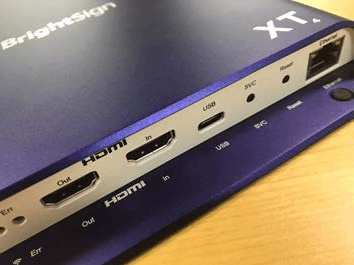Advertising in a Digital Landscape
Digital signage has become a powerful advertising tool for many businesses across the world. Their increasing popularity has many employers seeking new ways to implement digital screens for their businesses. However, there is a lot to consider outside of just digital screens. Before you integrate digital marketing displays, you must weigh the pros and cons digital signage will have on your communication strategy. Doing so will not only tell you if digital signage is right for you but also how to utilize the strengths of the medium.
Choosing the Right Tool
Before you even get your signage up and running, you will have to decide what hardware to run and which software provider to partner with. There are many software providers and even more hardware options. So how do you choose a good digital signage platform?

The hardware typically includes setting up a player to an internet connection and then hooking it up to a display via an HDMI cord. However, some players, like an Amazon TV or Intel Compute Stick, can plug directly into your displays. The key to picking hardware right for you depends on how you plan to use your digital signage software. For some companies, a simple Fire Stick is enough to display basic advertising on. By comparison, a Brightsign player is more powerful and capable of performing advanced functionality (such as live streaming).
Luckily for you, REACH is both a hardware and software provider. We will work with you to determine which player best suits your needs. In addition, our team will be with you at each step of the installation process. We encourage you to browse our hardware catalog to see what options are available to you. You can also request a free demo by clicking here.
The Pros of Digital Signage
1. Attention Grabbing Displays

One of the most obvious advantages of digital signage is that it receives substantially more attention than traditional media. Not only that, but it also makes a bigger impact with a higher retention rate. Digital signs use bright colors and graphics that easily draw attention. From there, it is a more captivating viewing experience. Dynamic elements such as video can be utilized alongside other apps and integrations. A large amount of information can be passed to your viewers in a relatively short amount of time. This encourages repeat visits for fresh content over time.
In addition, digital signage can engage viewers in unique ways. Elements such as QR codes and touchscreens add a degree of interactivity to your communication. This can make consumers feel more connected to your brand.
2. Greater Creative Freedom & Utility
When using digital signage software, you have access to more tools than traditional media. Adding animations, different fonts, and other digital assets stylize your content in eye-catching ways. In addition, digital screens allow for an unlimited number of slides to work with. This means you can include as many announcements and information you want!
However, digital signage can also provide a service for viewers too. For instance, a public transportation company can display live traffic routes for wayfinding purposes. A business can post company social media pages to streamline internal communications.
These dynamic apps supplement your standard advertising to give viewers more reasons to stay engaged. This allows you to relay your messaging effectively while providing some type of utility to your consumers.
3. Powerful Managment Tools
Most digital signage software providers (including REACH) employ cloud-based management software. This connects all your assets and tools to the cloud so they can be accessed at any time. Saving projects in the cloud also ensures computer crashes or power outages do not delete any of your work, as it will be all backed up!
Cloud-based management also enables your business to edit and update screens across multiple locations. This means a facility in New York can share assets with another facility in Chicago. This can help unify your messaging objectives and ensure everyone in your business is on the same page.
The Cons of Digital Signage
1. High Installation Costs

Getting digital signage up and running is a far more involved process than print media. LCD and OLED screens are much more expensive than printing a poster, and repair and maintenance costs can also tally up. Aside from that, you must pay internet and software costs as well.
Initially, this may seem a bit overwhelming. That’s why it’s important to understand what you are investing in. With proper planning and content, digital signs can actually turn profitable over time.
At REACH, we are invested in our clients’ success. That’s why we encourage you to read our comprehensive guide to digital signage. Additionally, our quick start guide will give you an idea of what to expect when setting up your signage.
2. Tech Expertise

Digital signage software is meant to be as user-friendly as possible. That being said, even a simple update will require more technical know-how than putting a pen on paper.
That is why at REACH, we make it a priority to equip our partners with the knowledge to succeed. Our team offers 24/7 support and routine training for all our clients. We also provide detailed, step-by-step guides on each tool within our software that can be referenced at any time. So when you ask yourself “How do I choose a good digital signage program?” know that REACH is here for you.
Ultimately, the advantages of digital signage far outweigh the negatives. Through proper training and guidance, digital signage can become an essential means of communication with your audience. REACH is ready to help you start that journey. Click the button below to request a free demo, today!



